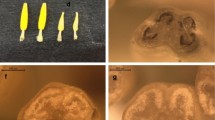Abstract
The male sterility gene from a male-sterile, green,Gelidium vagum line was introduced to a wild-type line through repeated backcrossing and selection for five generations. The plants from the recurrent parent, the male-sterile green, the backcross-5 fertile and the backcross-5 male-sterile lines were compared for their growth performance. The backcross-5, red, male-sterile plants grew at a significantly higher rate than the plants from other lines, suggesting that male-sterile gametophytes would likely be better candidates for aquaculture than normal wild-type plants of this species. This study also provides evidence that the growth rate ofG. vagum decreases as a consequence of reproduction.
Similar content being viewed by others
References
Haxo FT, Clendenning KA (1953) Photosynthesis and phototaxis inUlva lactuca gametes. Biol. Bull. (Woods Hole), 105: 103–114.
Juanes J, Borja A (1991) Biological criteria for the exploitation of the commercially important species ofGelidium in Spain. Hydrobiologia 221: 45–54.
Kremer BP (1975) Physiologisch-chemische Charakteristik verschiedener Thallusbereiche vonFucus serratus. Helgol. Wiss. Meeresunters. 27: 115–127.
Littler MM, Arnold KE (1980) Sources of variability in macroalgal primary productivity: sampling and interpretive problems. Aquat Bot. 8: 141–156.
Lobban CS (1978) Translocation of14C inMacrocystis pyrifera (giant kelp). Plant Physiol. 61: 585–589.
Patwary MU, van der Meer JP (1992) Genetics and breeding of cultivated seaweeds. Korean J. Phycol. 7: 281–318.
Patwary MU, van der Meer JP (1994) Application of RAPD markers in an examination of heterosis inGelidium vagum (Rhodophyta). J. Phycol. 30: 91–97.
Patwary MU, MacKay RM, van der Meer JP (1993) Revealing genetic markers inGelidium vagum (Rhodophyta) through the random amplified polymorphic DNA (RAPD) technique. J. Phycol. 29: 216–222.
Santelices B (1991) Production ecology ofGelidium. Hydrobiologia 221: 31–44.
van der Meer JP (1990a) Isolation and genetic characterization of self-sterile mutants in a monoecious red algaGelidium vagum. Proc. int. Seaweed Symp. 13: 389–395.
van der Meer JP (1990b) Self-sterile mutants ofGelidium vagum. In Miyachi S, Karube I, Ishida Y (eds) Current Topics in Marine Biotechnology. The Japanese Society for Marine Biotechnology, Tokyo: 205–208.
van der Meer JP, Patwary MU (1991) Genetic alleviation of the self-fertilization complication when hybridizing monoeciousGelidium vagum. Hydrobiologia 221: 167–179.
van der Meer JP, Patwary MU (1995) Genetic studies on marine macroalgae: a status report. In Wiessner W, Schnepf E, Starr RC (eds) Algae, Environment and Human Affairs. Biopress Ltd., Bristol, England: 235–258.
Author information
Authors and Affiliations
Rights and permissions
About this article
Cite this article
Patwary, M.U., van der Meer, J.P. Construction of backcrossedGelidium male-sterile and male-fertile lines and their growth comparison. J Appl Phycol 8, 483–486 (1996). https://doi.org/10.1007/BF02186326
Received:
Revised:
Accepted:
Issue Date:
DOI: https://doi.org/10.1007/BF02186326




